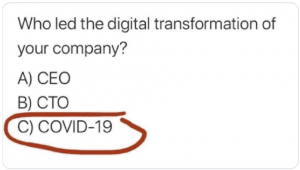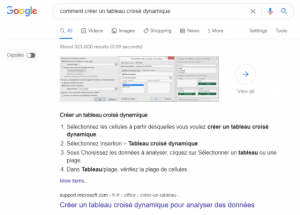To say that 2020 has been a year of twists and turns is an understatement. On the web side of things, it’s not like we’re not used to rapid change, but… oh boy 2020 is still keeping us on our toes. We have known for years that there is more and more money invested on the Web and the number of users continues to increase.
However, what characterizes the year 2020 on the web is the behavioral change of our online habits. E-commerce sales are exploding and the part of the industry that was still delaying the implementation of its web strategy has finally woken up. By the way, here is my favorite meme to sum it up.

After so many changes, what does 2021 hold in store? I’m no clairvoyant, but let’s take a look at the trends that are emerging for the next few months.
Third-party cookies: ready for 2022?
A few months ago, I told you about the end of third-party cookies and how web marketing was going to undergo a very profound change.
Quick info on the third-party cookie: this represents a cookie that is generated by an entity other than the site. The most common example is the Facebook pixel that collects data on online behavior. It is a decision of browsers such as Safari and Firefox to reduce malicious acts and improve privacy protection by no longer accepting the third-party cookie.
What does that actually mean? For most folks, not much. It may go quite unnoticed. But for all advertisers, that’s a different story!
It’s never been a secret that our behavioral data on the web is used to show us targeted advertising. Without third-party cookies, access to behavioral data is drastically reduced. Result? No more remarketing, no more personalized audiences and no more attribution for your multi-channel digital efforts (understanding where the traffic driving conversions is coming from).
Closing off the tap on certain behavioral data completely redefines the application of certain web campaigns. What does 2022 have in store for us? Hard to predict, but a decrease in audience accuracy is definitely on the horizon. Also, less precision in the target audience will have a downward effect on the revenue generated by digital campaigns.
Now is the time to rethink your strategy. Are you ready? We will be, so that we can discuss it with you.
Mobile, Mobile and… Mobile
We realized in 2020 that screens are pretty hard to avoid. On that note, this meme sums it up nicely for telecommuters.

The trend in mobile use, which was only increasing year over year, was catapulted by containment and telecommuting in 2020. In fact, in the last year in Canada, 53% of Canadians have made at least one online purchase with their mobile device.
What is interesting about 2020 compared to the past few years is that the impact of mobile is felt as much in its technical side as in its daily use. On the one hand, among the web giants, mobile browsing is the new hobbyhorse. We have been talking about Responsive Design in recommendation mode for years. More recently, mobile-first indexing has become standard on the Google Search Console.
However, Google is speeding up with the introduction of Core Web Vitals, a new component of the positioning factor on its search engine. The time has come to raise awareness of the fluidity of mobile browsing for Google. With the arrival of Core Web Vitals, an unpleasant display on mobile or tablet will have an impact on your web positioning. Google was already judging the technical side of a site, and it only gets worse with this new navigation standard.
On the other hand, although mobile use is well established in our lives before 2020, it is even more so at the end of the year. While access to the web through a mobile browser has increased over the past year, it really is the apps that have taken a big slice of the pie. Over the past year, virtually all major apps saw their downloads increase.
When you think of must-have apps, Tik Tok has ensured its popularity in 2020. It’s not just in entertainment that apps have taken over in our (confined) lives. Food delivery, home training, professional apps, and even telemedicine tools all had a record year.
Those who are doing well are those who had already understood the importance of mobile before the spring 2020 lockdown. For instance, have you noticed how Zoom suddenly stole the spotlight from Skype as a video conferencing tool?
The line between Push Marketing and Pull Marketing : more and more blurred
In marketing, the principle of “push” and “pull” defines ways of presenting advertising and the approach to the user. Push represents content that is promoted by advertisers with a target audience of some sort. The sweater is the strategy of being present in the search process of an individual who examines his possibilities for any need.
For example, a jewelry brand that reaches you with an advertisement on Instagram is in “push” mode. Unlike when you enter “honda rive-sud” and an advertisement from a Honda dealership (or other) appears in your search engine, we definitely speak of “pull”.
Push-type advertising produces an aversion reaction in many people. In web marketing, advertising has been trying to be more subtle and softer for several years now. For example, storytelling is increasingly used to wrap the ad or upstream, audience segmentation dramatically reduces the number of irrelevant ads you might see.
Also, influencers are one of the strategies used for soft push promotion. This blur between push and pull is increasingly blurred with the arrival of Facebook Shops and Instagram Shopping. The main reason for consulting its social networks is entertainment / communications, but these new features challenge this separation.
No one can say they love advertisement with conviction, but many of us unwind in unconstrained viewing of ad content while searching for a new outfit in Instagram Shopping. The attitude towards advertising is changing and the so distinct separation between push and pull is no longer redefined with so much contrast.
SEO : search engine or… answer engine?
In recent years, the search engine results page has undergone several transformations. We notice, more and more, the presence of new features on the results page, such as reviews, the ingredient list of a recipe, the location on Maps of a sought-after location and a whole array of new information on the same page without even having to click on a link.

It’s still true to call Google, Bing, Yahoo, and the likes a search engine, but there’s a lot more user-friendliness coming out of the results pages. Are we in transition to a response engine?
Already, the question format is used more and more as a query by users year after year. So what will be the vocation of SEO if the answers are already provided by Google? Already, we note that long tail keywords will become more and more important, but will they compensate for the traffic that will be lost in favor of the answers already available in the search engines?
In conclusion, 2020 and Covid-19 have not finished upsetting our habits. In fact, the Web is not the only sector that has undergone major changes. The workplace has entered a forced phase of transformative modernization that no one saw coming. Companies cautious about teleworking had to adapt to it at high speed. Unemployment as we knew it had to be reviewed fairly quickly when the first lockdown began last March. Also, what does the future have in store for Covid graduates? The work environment is definitely different for the next generation. And what about networking? The 2020 legacy leaves many questions unanswered!

